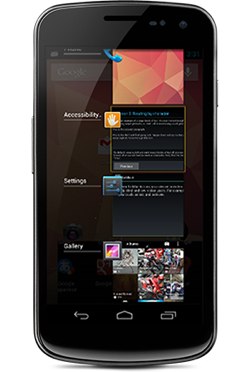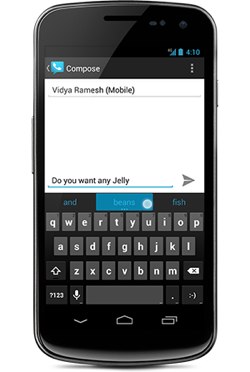Since Google announced Android 4.1 (“Jelly Bean”) on June 27, the update has appeared on Galaxy Nexus phones, and this week showed up on Google’s Nexus 7 tablet. Last week, Google released Android 4.1 source code along with developer background, and this week followed up with a changelog offering further details. A number of in-depth reviews have also appeared in recent days.
 Now that Jelly Bean has been more thoroughly chewed over, what have we learned? Is this just a consumer confection, or is there anything here for the enterprise?
Now that Jelly Bean has been more thoroughly chewed over, what have we learned? Is this just a consumer confection, or is there anything here for the enterprise?
Some of the hottest new features will be of tangential importance to the enterprise, at least for now. The new Google Play and Google+ features, Android Beam improvements, and camera features are cool indeed, but are not yet essential to most enterprises. The fledgling Google Now voice search extension may well be better than Apple’s Siri, but it’s currently of limited corporate utility.
Still, there’s plenty in Android 4.1 to interest enterprise customers, including accessibility, security, and localization enhancements, improved notifications and a better predictive keyboard. Jelly Bean also seems quite stable, thereby building confidence among IT leaders. The buggy Android 3.0 (“Honeycomb”) seems like a distant memory.
Here are some Jelly Bean features that enterprises should love, including accessibility and keyboard features recently illuminated by the changelog:
Project Butter — The underlying technology delivers smoother UI transitions and better responsiveness. Specifics include improved vsync timing for faster frame rates, triple graphic buffering, touch anticipation, and a systrace tool that collects performance data from the Linux kernel.
The reviews agree that Project Butter provides the sensation of smoother, faster performance. In PhoneArena’s tests, Jelly Bean “often” made the Galaxy Nexus outperform the faster new Galaxy S III running Android 4.0 (“Ice Cream Sandwich”). The Verge review noted that while benchmarks were similar to ICS, Jelly Bean “felt” faster, especially when multitasking. “The overall feeling of responsiveness is just plain better,” wrote reviewer Dieter Bohn.
TechRadar’s JR Bookwalter not only praised Project Butter, but reported the Galaxy Nexus booted in 34 seconds with Android 4.1, compared to 50 seconds with Android 4.04. Concluded Bookwalter: “Android is now fast, fluid and ready to go toe-to-toe with Apple on performance and features.”
Accessibility — Android 4.1 now appears to be much easier for blind users. This is especially good news for organizations that need to meet client and regulatory requirements.
Both the blind and the sighted will appreciate the new offline voice dictation, as well as the major improvements to voice search, voice recognition, and text-to-speech. New accessibility tools include a gesture mode that integrates touch with speech output, and plugin support to enable external Braille I/O devices. Other enhancements include an accessibility focus feature, improved text-traversal controls, and an upgraded TalkBack screen reader.
 Keyboard — With corporate users increasingly using virtual keyboards as their primary input, Jelly Bean’s keyboard enhancements are especially welcome. As noted in the changelog and several reviews, predictive typing and autocorrect are much more fluid and accurate. The keyboard language model adapts to users over time, and the firmware provides more custom keyboards and input styles. According to The Verge’s Bohn, the SwiftKey-like upgrade is “the first Android keyboard that hasn’t sent me running to third party alternatives.”
Keyboard — With corporate users increasingly using virtual keyboards as their primary input, Jelly Bean’s keyboard enhancements are especially welcome. As noted in the changelog and several reviews, predictive typing and autocorrect are much more fluid and accurate. The keyboard language model adapts to users over time, and the firmware provides more custom keyboards and input styles. According to The Verge’s Bohn, the SwiftKey-like upgrade is “the first Android keyboard that hasn’t sent me running to third party alternatives.”
Security — Aside from announcing enhancements to device encryption and the Android 4.0’s Face Unlock function, Google had little to say about security. Yet, a July 16 analysis by Duo Security’s Jon Oberheide reported that the ASLR (address space layout randomization) feature that debuted in ICS to thwart malware exploits has been vastly improved. (The advance was confirmed by Accuvant researcher Charlie Miller in Ars Technica.) For the first time, Android comes close to matching iOS’ malware protection, thereby greatly reducing one of the major arguments against Android in the enterprise.
ASLR aims to confuse malware with a digital shell game based on randomizing the memory locations of key data structures. The ICS version was said to be largely useless because it didn’t randomize the executable and linker memory regions.
Jelly Bean fills these gaps, and adds security enhancements such as hardened binaries and an “infoleak prevention” capability borrowed from the Linux kernel that shields memory buffers from unauthorized inspection. It also improves Data Execution Prevention (DEP) to stop malware from executing code from a non-executable memory region.
UI — Jelly Bean’s user interface has been refined with a more buttoned-down, understated appearance that should please corporate professionals. As Bohn notes, “the Tron-like futurism that was introduced in Honeycomb has been almost entirely excised.” Other UI improvements include an expanded search interface, resizable app widgets, and simplified task navigation. In addition, Adobe Flash is gone, replaced by much-improved HTML5 support, and Chrome is now the official browser.
Notifications — Corporate developers have always liked Android’s notifications, and the latest version should continue that trend. Jelly Bean displays larger, richer notifications that can be expanded and collapsed. In addition, users can respond to notifications without having to open the related app, email and SMS notifications have improved, and developers can use APIs to develop new notification actions.
Clouds, localization, and more — Android 4.1’s Google Cloud Messaging (GCM) feature enables developers to send SMS texts toAndroid devices without requiring a proprietary sync solution. Meanwhile, improved internationalization support includes support for right-to-left scripts. Finally, there are a host of minor improvements that should play well in the enterprise, including enhancements to the calendar as well as that oft-forgotten feature: the phone.


